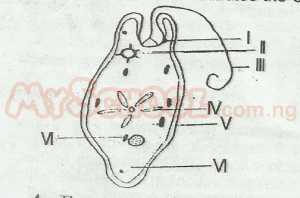Year :
1989
Title :
Biology
Exam :
WASSCE/WAEC MAY/JUNE
Paper 1 | Objectives
1 - 10 of 68 Questions
| # | Question | Ans |
|---|---|---|
|
Below is a List of the levels of organization in organisms. |
||
| 1. |
Which of the following structures is responsible for osmoregulation? A. I B. II C. III D. IV E. V |
B |
| 2. |
Excretion is carried out through the structure labelled A. I B. III C. IV D. V E. VI |
D |
| 3. |
The part labelled VII is made up of A. carbohydrates B. lipid materials C. waste materials D. protein materials E. food particles |
B |
| 4. |
The correct sequence of the levels in an increasing order of complexity is A. I,II,III B. lll, I, l\/, ll C. lll, IV, l, ll D. lV, lll, I, ll E. IV, l, ll, lll |
B |
| 5. |
Which of the following organelles is used for locomotion in Paramecium? A. pseudopodium B. Trchocyst C. Cilium D. pellicle E. Contractile vacuole |
C |
| 6. |
Which of the following is not true of the nucleus of a living cell? It contains A. chromosome B. Nucleolus C. nucleoplasm D. chromatids E. ribosomes Detailed Solution From the above diagram, we see that the components of the nucleus excludes ribosomes. |
|
| 7. |
The cell membrane consists of A. carbohydrates and lipids B. vitamins and proteins C. lipids and proteins D. water and sugar E. starch and cellulose |
C |
| 8. |
Which of the following is not likely to be found in the cell of a ripe tomato fruit? A. plastids B. Chlorophyll C. Cellulose cell wall D. Mitochondrion E. Mineral salts |
B |
| 9. |
Which of the following constitutes the main internal tissue of a leaf? A. Cuticle B. Mesophyll C. Vascular tissue D. Lower epidermis E. Upper epidermis |
B |
| 10. |
Four cells with osmotic potential equivalent to that of 3% salt solution were immersed respectively in solutions A. I B. II C. III D. IV E. V |
C |
|
Below is a List of the levels of organization in organisms. |
||
| 1. |
Which of the following structures is responsible for osmoregulation? A. I B. II C. III D. IV E. V |
B |
| 2. |
Excretion is carried out through the structure labelled A. I B. III C. IV D. V E. VI |
D |
| 3. |
The part labelled VII is made up of A. carbohydrates B. lipid materials C. waste materials D. protein materials E. food particles |
B |
| 4. |
The correct sequence of the levels in an increasing order of complexity is A. I,II,III B. lll, I, l\/, ll C. lll, IV, l, ll D. lV, lll, I, ll E. IV, l, ll, lll |
B |
| 5. |
Which of the following organelles is used for locomotion in Paramecium? A. pseudopodium B. Trchocyst C. Cilium D. pellicle E. Contractile vacuole |
C |
| 6. |
Which of the following is not true of the nucleus of a living cell? It contains A. chromosome B. Nucleolus C. nucleoplasm D. chromatids E. ribosomes Detailed Solution From the above diagram, we see that the components of the nucleus excludes ribosomes. |
|
| 7. |
The cell membrane consists of A. carbohydrates and lipids B. vitamins and proteins C. lipids and proteins D. water and sugar E. starch and cellulose |
C |
| 8. |
Which of the following is not likely to be found in the cell of a ripe tomato fruit? A. plastids B. Chlorophyll C. Cellulose cell wall D. Mitochondrion E. Mineral salts |
B |
| 9. |
Which of the following constitutes the main internal tissue of a leaf? A. Cuticle B. Mesophyll C. Vascular tissue D. Lower epidermis E. Upper epidermis |
B |
| 10. |
Four cells with osmotic potential equivalent to that of 3% salt solution were immersed respectively in solutions A. I B. II C. III D. IV E. V |
C |
